.
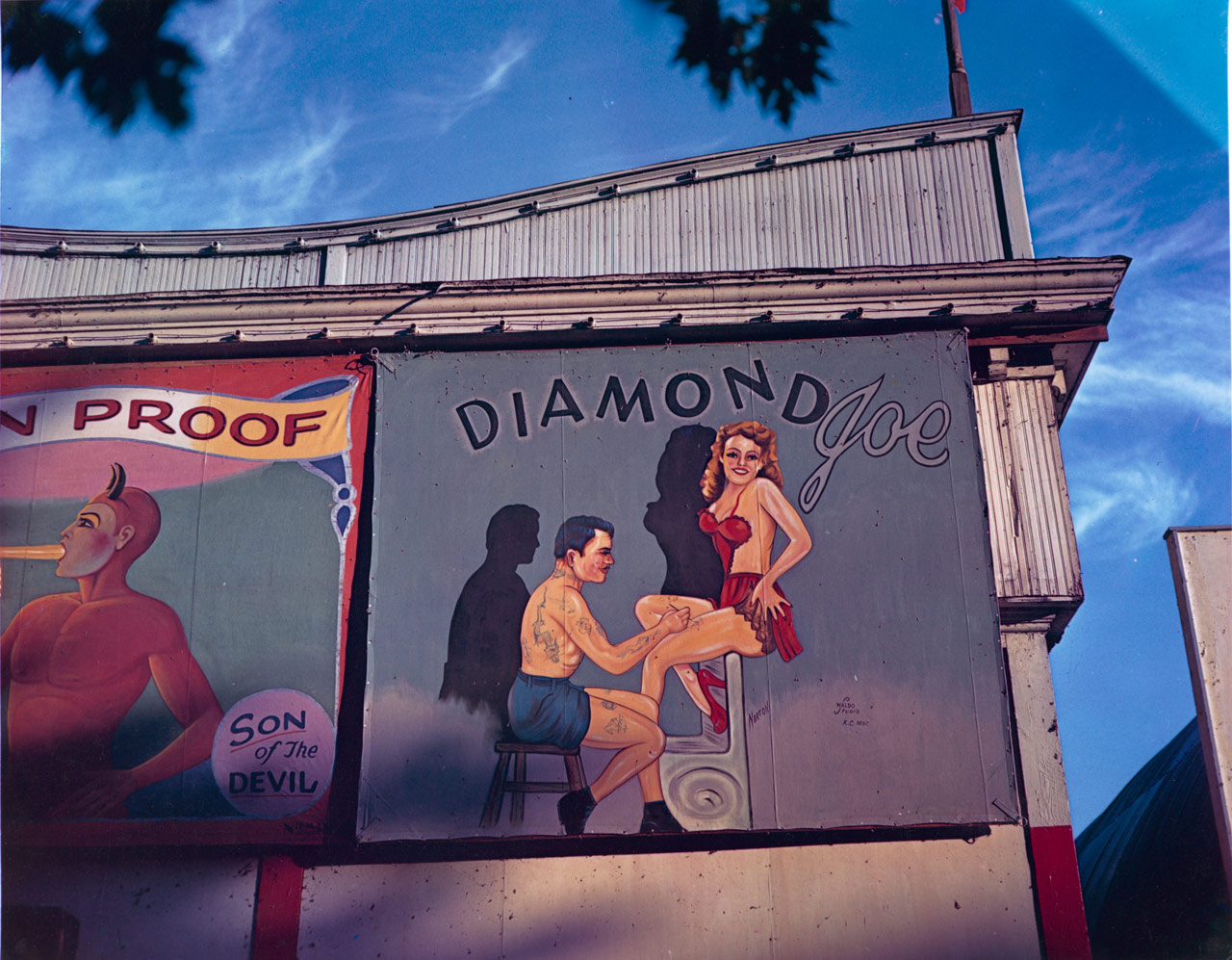
Circus sideshow billboards, Santa Monica, California: photo by Walker Evans, August-September 1967 (Walker Evans Archive/Metropolitan Museum of Art, New York)
Feeling the way I did, alone and friendless, with the future very black, I did not want to get out on the streets and see what the sun had to show me, a cheap town filled with cheap stores and cheap people, like the town I had left, identically like any one of ten thousand other small towns in the country -– not my Hollywood, not the Hollywood you read about. This is what I was afraid of now, I did not want to take a chance on seeing anything that might have made me wish I had stayed home, and this is why I had waited for the darkness, for the night-time. That is when Hollywood is really glamorous and mysterious and you are glad you are here, where miracles are happening all around you, where today you are broke and unknown and tomorrow you will be rich and famous. . . .
On
Vine Street I went north towards Hollywood Boulevard, crossing Sunset,
passing the drive-in stand where the old Paramount lot used to be,
seeing young girls and boys in uniform hopping cars and seeing, too, in
my mind, the ironic smiles on the faces of Wallace Reid and Valentino
and all the other old-time stars who used to work on this very spot, and
who now looked down, pitying these girls and boys for working at jobs
in Hollywood they might just as well be working at in Waxahachie or
Evanston or Albany; thinking if they were going to do this, there was no
point in their coming out here in the first place.
THE BROWN DERBY, the sign said, and I crossed the street, not wanting to pass directly in front, hating the place and all the celebrities in it (only because they were celebrities, something I was not), hating the people standing in front thinking: You'll be fighting for my autograph one of these days...
*
That
night I discovered the park at De Longpre and Cherokee. I was walking
around the streets in the neighborhood, Fountain and Livingston and
Cahuenga, because they were dark and lonely, looking at all the small
houses, telling myself that these were where Swanson and Pickford and
Chaplin and Arbuckle and the others used to live in the good old days
and what a shame it was they had to pass, feeling a personal loss that
was still very warm and nostalgic, like a visit to a graveyard where
your grandfather and grandmother and all your relatives are buried. You
don't feel that you are a stranger even though you have never visited
the graveyard before because the tombstones represent something and
somebody you have known a long, long time, and loved, and it was like
that now. I was no stranger on these streets. . . .
I came upon the park suddenly. At first I thought it was the yard of some house, because you don't expect a city park to be as small as this one was; it covered only half a block. But when I saw the benches around and the sign telling you to keep off the grass, I knew what it was. I sat down on a wet bench and looked around. There was nobody else there, which was right and proper. It was still misting a little, and all the other fools were inside their little houses.
There was a red haze above the boulevard eight blocks north, thrown up by the neon signs. The only building you could see over the tops of the small houses was the Catholic church on Sunset, its white spire sticking straight up into the black sky.
Presently I was aware that there was someone else in the park. I looked around, behind me, and saw a figure silhouetted in light from the single globe that was fixed on top of some kind of grass shelter. I couldn't tell whether it was a man or a woman. It was on its knees, in front of a small fountain, in an attitude of prayer, its hands moving rapidly in some kind of Oriental gesture. This continued for a few minutes and then the figure got up and walked past me out of the park. It was a woman, a middle-aged woman, dressed entirely in black.
I walked over to the fountain. It was a fish-pond and what I had thought was a fountain was a statue. The statue was about three feet high, a figure with arms at its side, its head lifted. I leaned forward, looking at the tablet.
ASPIRATION
Erected in memory of Rudolph
Valentino
1895.....................1926
1895.....................1926
Presented by his friends and
admirers from every walk of
life -- in all parts of the world
in appreciation of the Happiness
brought to them by his
cinema portrayals.
admirers from every walk of
life -- in all parts of the world
in appreciation of the Happiness
brought to them by his
cinema portrayals.
On the railing around the pond, in front to the statue, was the single gardenia the woman had left.
"I know how you feel, lady," I said to her in my mind. "I know exactly how you feel. . . ."
Horace McCoy (1897-1955): from I Should Have Stayed Home, 1938

Young woman standing on sidewalk with suitcase, Hollywood, California: photo by Russell Lee, April 1942 (Farm Security Administration/Office of War Information Collection, Library of Congress)

Young woman standing on sidewalk with suitcase, Hollywood, California: photo by Russell Lee, April 1942 (Farm Security Administration/Office of War Information Collection, Library of Congress)
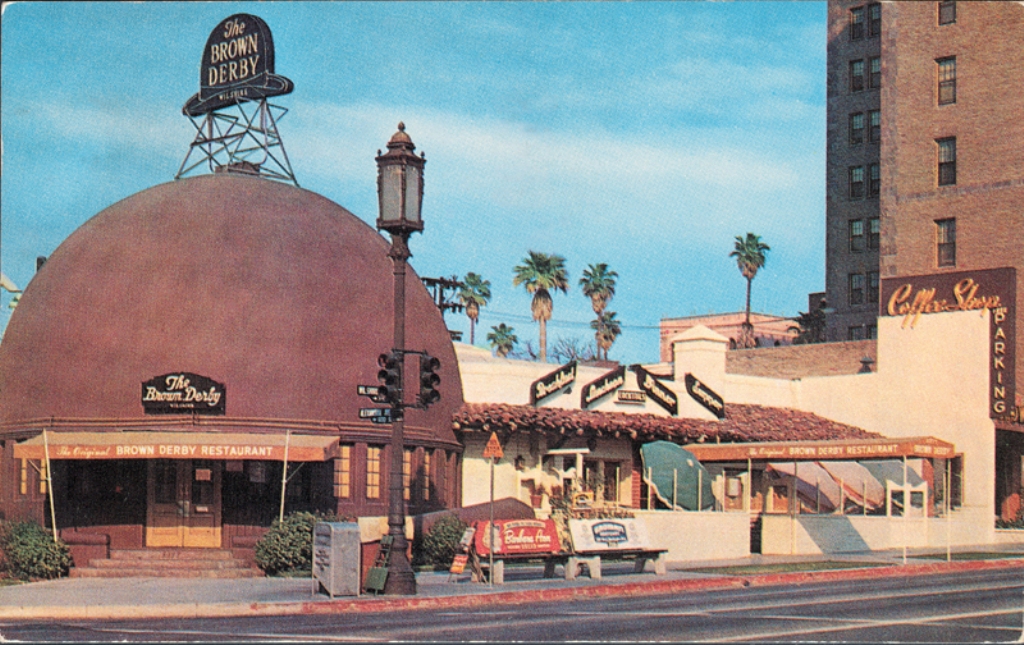
The Brown Derby, Wilshire and Alexandria, Los Angeles: postcard, photographer unknown, c. 1955 (James Rojas Collection, Dorothy Peyton Gray Transportation Library and Archive)
The original Brown Derby, Wilshire Boulevard, Los Angeles: photo by Chalmers Butterfield, n.d.; image by liftarn, 14 August 2007

Rudolph Valentino Aspiration Statue, De Longpre Park, Hollywood: photo by mercycube, 4 October 2008

Rudolph Valentino Aspiration Statue, De Longpre Park, Hollywood: photo by mercycube, 4 October 2008

Rudolph Valentino Aspiration Statue, De Longpre Park, Hollywood: photo by mercycube, 4 October 2008

Rudolph Valentino Aspiration Statue, De Longpre Park, Hollywood: photo by mercycube, 4 October 2008
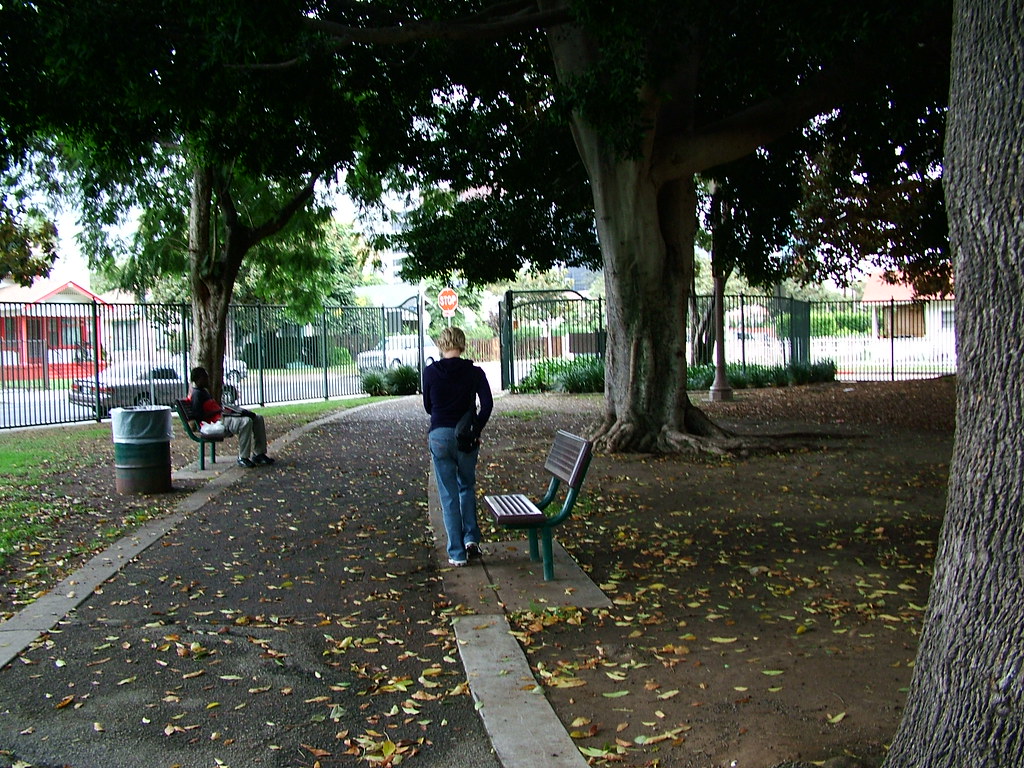
De Longpre Park, Hollywood: photo by mercycube, 4 October 2008
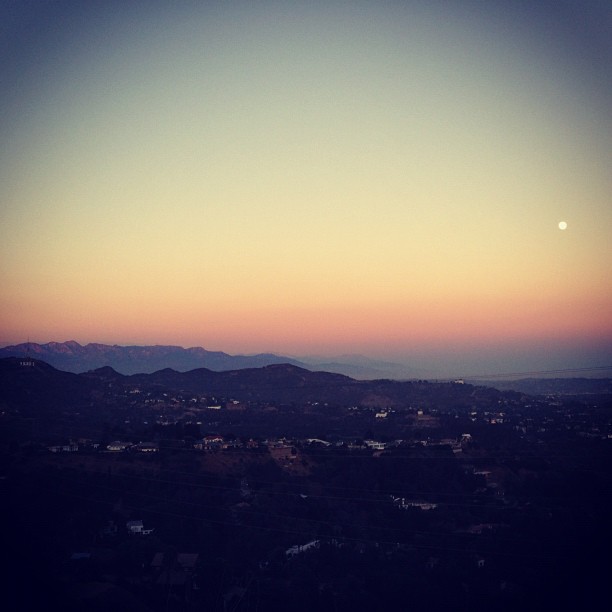
View of the (almost) Harvest Moon, Observatory and Hollywood sign above Runyon: photo by julie neumann, 22 October 2012

Bucolic scene along Mulholland Drive in the Santa Monica Mountains on the western edge of Los Angeles. The mountains contain the last semi-wilderness in Los Angeles County. Some 84 percent of the state's residents live within 30 miles of the coast, and this concentration has resulted in increased land use pressure. Of the 1,072 miles of mainland shoreline (excluding San Francisco Bay) 61 percent is privately owned: photo by Charles O'Rear for the Environmental Protection Agency's Documerica Project, May 1975 (US National Archives)
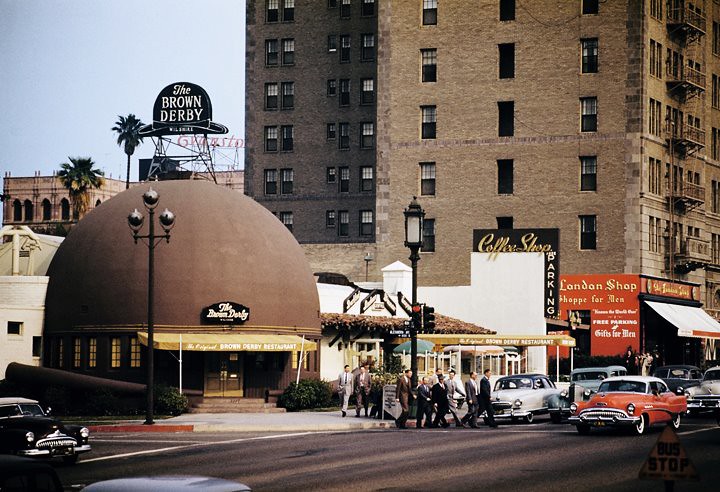

Horace McCoy grew up in backwoods Tennessee, served in France in the First World War as an aerial observer, was wounded twice and awarded the Croix de Guerre by the French government. After the war he worked as a newspaperman in Dallas, wrote "hard-boiled" stories for the pulps, and had some success as a leading man on stage. The offer of a screen test at MGM induced him to head for Hollywood in 1931. He was a flop at movie acting but able to survive in the Lower Circles of Tinseltown by taking on pick-up writing jobs on scenarios and story treatments. Over the years he turned out screenplays for some two dozen pictures, including The Trail of the Lonesome Pine (1936), Persons in Hiding (1938), Gentleman Jim (1942, the biopic of prizefighter James J. Corbett), and The Lusty Men (1952, a signature film for Robert Mitchum).
ReplyDeleteThis novel, the third of six McCoy would produce, draws on his own experiences -- and discontents -- in Hollywood. It follows three years after another down-side tale of life in Depression America, the work for which McCoy became best known -- some fourteen years after his death -- when it was turned into a film by Sidney Pollack.
My own first visit to Southern California came in 1951. Much of that summer was passed in a baffling envelope of mist and drizzle in a motel down by the beach in Santa Monica. First glimpse of a supermarket. Hollywood Stars games on the pocket radio. The pocket notebook for celebrity autographs. Entire afternoons haunting the Brown Derby entrance. Adolphe Menjou and Walter Pidgeon the most salient captures. Each celebrity scribble to a pocket size page of its own. At the end of the summer I went back home.
We live The Simulacrum (a ten-dollar word for fake, phony, ersatz)—an empty show that doesn’t comprehend its own emptiness. The edges around the toxic American dream have grown dark, murky, indistinct. The line’s been blurred between the real and what’s playing on the screens of varying shapes and sizes in which we lose ourselves. Overhead is that rich and famous sky the Valentino-inspired statue is forever staring into, as if expecting validation. Let’s not kid ourselves: that sculpture is really an advertisement for the chiropractor just down the block, whose specialty is neck adjustments.
ReplyDeleteHazen,
ReplyDeleteEver since last-year's passive encounter with the speeding Jetta, I have zero mobility in the cervical vertebrae (0-3), so merely looking at the unnatural and impossible angle of "aspiration" in the Valentino statue is fresh reminder of the terrible truth of the lie that is Entertainment.
(Wasn't that the slogan??)
The somewhat schmaltzy attitude of McCoy's narrator in the second excerpt here betrays a weakness in the novel. McCoy had mixed feelings (and then some) about the movies. In this book he seems to have split himself in two, or more accurately represented both sides of a personal dilemma, by inviting us into the highly contrasting POVs of two principal male characters, the hunky, somewhat depressive, slightly sentimental soft-touch Southerner Ralph who narrates the tale, and a more cynical, hard-edge political pragmatist named Johnny, who represents the "Hollywood Left" of the period.
The characterizations are limited, but the atmosphere/period context make the book a useful read. I enjoy McCoy. Much as, from the same period, Cain, Thompson, Hammett et al. He wrote for the same magazines they did, though he never recycled magazine pieces into novels (as they did).
That postage-stamp-size DeLongpre Park is now a "questionable" patch on the urban map, lots of muggings, not a good place to stroll after dark.
Back in the day, the Nelson Family of American Culture fame lived just two blocks from there (at 1822 Camino Palermo).
Ricky, already a slow-blinking low rider at Hollywood High, used to sneak off to hang out there between classes in the wee park, under the dark, rat-filled palms, on a bench, with his guitar, doing what I guess is now termed "chill". In fact it was in that park, with that guitar, that he composed Travelin' Man.
For a long time that site seemed to me the epicenter of something intangible and perhaps inchoate. But L/A changed. Ricky went down in that plane. In my mind, the myth of the family had to be relocated.
Reading through this and looking at the pictures, for all the mixed feelings, bitter-sweetness and beauty mixed with ugliness, has already made me forget that I woke up thinking that I might not enjoy this day. I've never read McCoy's books, but I'm familiar with most of the movies you mention, and think I would like to, whatever their weaknesses might be. I remember a long time ago feeling dizzy with shock and confusion emerging from seeing They Shoot Horses, Don't They? Whether things are going really well or I'm stressed out, I have loved the times I've spent in Los Angeles to an almost unnatural degree, even to the point that I kind of like certain people there who I would otherwise dislike (and do dislike when I meet them outside of LA). I don't know why, but apart from the weather, the orange juice and the low price of avocados, I think it's the unconscious familiarity I've always felt with the surroundings. You drive somewhere, you walk somewhere, you jog somewhere and it's always somewhere you feel you've been and seen before because you probably have, in some movie or tv show. And the Pacific is always nice to see and be near even if the beaches are pretty horrible. And Hollywood will always be uniquely scary and edgy, much more so than Times Square ever was, no matter how hard they might try to clean it up and Disney-fy it (like Times Square). Curtis
ReplyDeleteCurtis,
ReplyDeleteHollywood scary vs Times Square scary sounds like one of those old Japanese sci fi confrontations: Mothra vs Godzilla, for example.
I think I'd agree that Hollywood is scarier, but I'll have to say that perhaps the second longest white night of my life was spent in a room in the Hotel National, directly above Times Square.
The only night scarier than that was one spent on a bench in a laundromat in London, where I'd been locked in overnight. Don't ask.